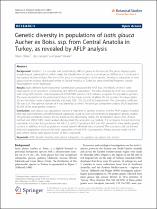Genetic diversity in populations of Isatis glauca Aucher ex Boiss. ssp. from Central Anatolia in Turkey, as revealed by AFLP analysis

Göster/
Erişim
info:eu-repo/semantics/openAccessAttribution 2.0 Generic (CC BY 2.0)https://creativecommons.org/licenses/by/2.0/Tarih
2013Üst veri
Tüm öğe kaydını gösterKünye
Özbek, Ö., Görgülü, E., Yıldırımlı, Ş. (2013). Genetic diversity in populations of Isatis glauca Aucher ex Boiss. ssp. from Central Anatolia in Turkey, as revealed by AFLP analysis. Botanical Studies, 54(1), 48.Özet
Background Isatidae L. is a complex and systematically difficult genus in Brassicaceae. The genus displays great morphological polymorphism, which makes the classification of species and subspecies difficult as it is observed in Isatis glauca Aucher ex Boiss. The aim of this study is characterization of the genetic diversity in subspecies of Isatis glauca Aucher ex Boiss. distributed widely in Central Anatolia, in Turkey by using Amplified Fragment Length Polymorphism (AFLP) technique. Results Eight different EcoRI-MseI primer combinations produced 805 AFLP loci, 793 (98.5%) of which were polymorphic in 67 accessions representing nine different populations. The data obtained by AFLP was computed with using GDA (Genetic Data Analysis) and STRUCTURE (version 2.3.3) software programs for population genetics. The mean proportion of the polymorphic locus (P), the mean number of alleles (A), the number of unique alleles (U) and the mean value of gene diversity (He) were 0.59, 1.59, 20, and 0.23 respectively. The coancestry coefficient was 0.24. The optimal number of K was identified as seven. The principal component analysis (PCA) explained 85.61% of the total genetic variation. Conclusion Isatis glauca ssp. populations showed a high level of genetic diversity, and the AFLP analysis revealed that high polymorphism and differentiated subspecies could be used conveniently for population genetic studies. The principal coordinate analysis (PCoA) based on the dissimilarity matrix, the dendrogram drawn with UPGMA method and STRUCTURE cluster analysis distinguished the accessions successfully. The accessions formed distinctive population structures for populations AA, AB, E, K, and S. Populations AG1 and AG2 seemed to have similar genetic content, in addition, in both populations several hybrid individuals were observed. The accessions did not formed distinctive population structures for both populations AI and ANP. Consequently, Ankara province might be the area, where species Isatis glauca Aucher ex Boiss. originated. © 2013 Özbek et al.


















